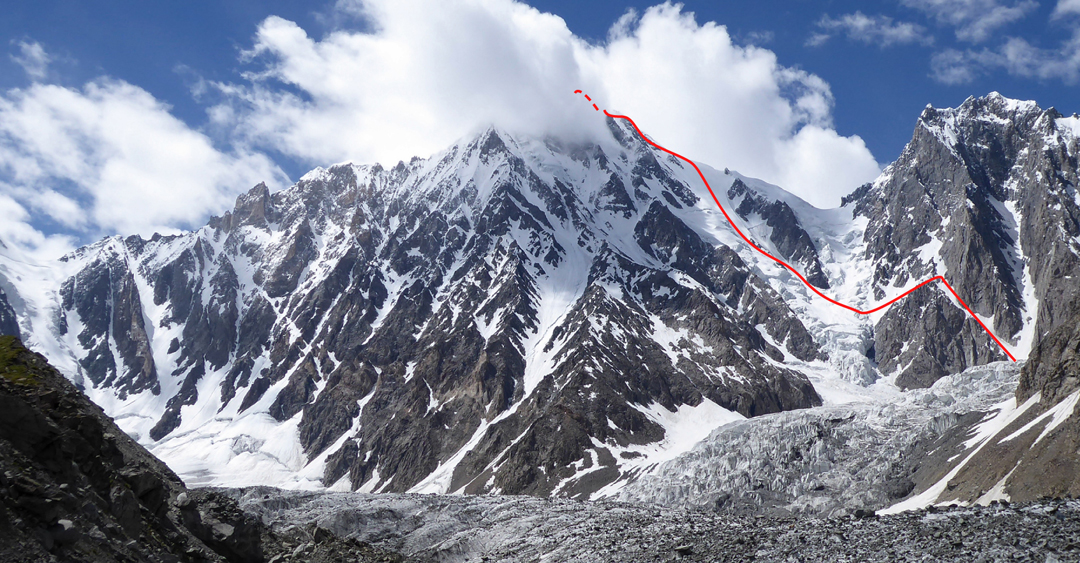Jinnah Peak, Southeast Face and East Ridge
Pakistan, Hindu Raj

Italian climbers and trekkers have been visiting parts of the Hindu Raj on or around the Chiantar Glacier ever since Franco Brunello’s first expedition in 1997. The highest peak in this subrange is Koh-i-Chiantar (6,416m), first climbed in 1967 by an Austro-German team from the Chiantar Glacier. Since Brunello’s first trip, ten more Italian parties have returned to the Chiantar Glacier area, most recently in 2015. Only one 6,000m peak remained virgin: Peak 6,177m above the northwest corner of the Soot (a.k.a. Suj) Gah Glacier on the watershed with the Chiantar. Anticipating climbing this mountain, we had already decided to name it Jinnah Peak after Mohammed Ali Jinnah, the first president of Pakistan.
Approaching via Ishkoman, we began our trek from the village of Ghotolti (2,530m). In 2009, the Montagne e Solidarietà Association, which is financed by Italian contributors, built an aqueduct and fountain here; in 2013 a new iron bridge (carried from Italy in pieces) was installed. A community climbing center is under construction—a refuge that can host tourists and mountaineers in this “forgotten” area, and which will give local people the opportunity for work.
Tarcisio Bellò planned to spend 30 days coordinating work on the refuge and then join Mara Babolin and me for an attempt on Peak 6,177m (Jinnah Peak). We established base camp at the Gashukis Lakes (3,894m) just below the Soot Gah Glacier. To acclimatize, we made an ascent of Brocca Peak (Broken Peak, 5,040m, 36°40'50.05"N, 73°46'21.02"E) via the west face and northwest ridge (220m, D+ 80° UIAA IV). Brocca Peak was climbed during a 2004 expedition, but it has been impossible to evaluate whether the climbers reached the true summit.
 We then turned to Jinnah Peak (36°42'48.58"N, 73°42'28.67"E) and put a camp below the southeast face at 4,600m. Access to this face is barred by a jumbled icefall. To outflank this, we climbed a 400m, 45–50° couloir (dubbed Couloir Steck after the legendary Swiss who had recently died on Nuptse) between a rock buttress and the main face of the unnamed peak east of Jinnah (estimated to be 5,700m). This led to a notch at 5,050m, from which we descended for two rope lengths on the far side (toward Jinnah Peak) and then slanted left above the worst part of the icefall. At first there was icefall danger, but this lessened considerably as we gained height. Three pitches over rock (UIAA IV) brought us to the main slope leading to the east ridge. This went on forever: snow at 50° and four pitches of ice at 60–65°. We reached the east ridge at 5,800m, and from there the summit looked close. It wasn't, and there were icy sections that needed screws guarding the top.
We then turned to Jinnah Peak (36°42'48.58"N, 73°42'28.67"E) and put a camp below the southeast face at 4,600m. Access to this face is barred by a jumbled icefall. To outflank this, we climbed a 400m, 45–50° couloir (dubbed Couloir Steck after the legendary Swiss who had recently died on Nuptse) between a rock buttress and the main face of the unnamed peak east of Jinnah (estimated to be 5,700m). This led to a notch at 5,050m, from which we descended for two rope lengths on the far side (toward Jinnah Peak) and then slanted left above the worst part of the icefall. At first there was icefall danger, but this lessened considerably as we gained height. Three pitches over rock (UIAA IV) brought us to the main slope leading to the east ridge. This went on forever: snow at 50° and four pitches of ice at 60–65°. We reached the east ridge at 5,800m, and from there the summit looked close. It wasn't, and there were icy sections that needed screws guarding the top.
From the summit we made seven rappels to regain the point at which we had reached the east ridge (snow stakes, Abalakovs, ice bollards) and another 25 rappels down to the top of the main ice fall. From there we climbed back up to the notch and made another seven rappels down the Couloir Steck.
We had begun the climb from our camp at 4:30 a.m. on June 30, reached the summit at 8 p.m., and regained our tent at 8 a.m. on July 1. Our timing had been perfect. By 11 a.m. it was snowing, and when we came back to base camp on the 2nd it rained for the next two days. We named the route Ghotolti Dreams (1,500m, TD 70° IV).
Francesco Rota Nodari, Italy






